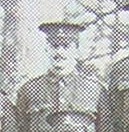CSM
George Levitt
Information about birth
|
Date of birth: 04/04/1891 |
|
Place of birth: Wittersham, Kent, England, United Kingdom |
General information
|
Last known residence: Battle, Sussex, England, United Kingdom |
|
Profession: Gardener |
Army information
|
Country: England, United Kingdom |
|
Force: British Expeditionary Force |
|
Rank: Company Serjeant Major |
|
Service number: GS/8569 |
|
Enlistment place: Lewes, Sussex, England, United Kingdom |
|
Units: — Queen's Own (Royal West Kent Regiment), 11th Bn. (Lewisham) (Last known unit) |
Information about death
|
Date of death: 31/07/1917 |
|
Place of death: Casualty clearing station, Godewaersvelde, France |
|
Cause of death: Died of wounds (D.O.W.) |
|
Age: 26 |
Cemetery
|
Godewaersvelde British Cemetery Plot: I Row: A Grave: 32 |
Distinctions and medals 3
|
British War Medal Medal |
|
Military Medal Medal — 31/03/1917 |
|
Victory Medal Medal |
Points of interest 5
| #1 | Place of birth | ||
| #2 | Last known residence | ||
| #3 | Enlistment place | ||
| #4 | Place of wounding | ||
| #5 | Place of death (approximate) |
My story
George was the eldest son of John & Charlotte Levitt. He had three other brothers. In 1911, the family lived in Catsfield near Battle, Sussex. Like his father, George worked as a gardener. During the war, George joined the army in Lewes, Sussex. When he married Mary Isabel Martin in April 1916, he already held the rank of sergeant in the 11th battalion Queen's Own (Royal West Kent). After completing training at Aldershot, Kent, the battalion was sent to France where it disembarked on 3 May 1916. A few weeks later, they had their first battles at Ploegsteert.
On 24 March 1917, George was awarded the Military Medal for his commitment and coolness during a heavy artillery bombardment at "la Douve" near Messines. He was by then sergeant major to Captain Wright. In July 1917, the Royal West Kents were sent to positions west of the village of Hollebeke, along the Ypres-Komen Canal. They arrived on 24 July and immediately received heavy artillery fire. On 31 July, the opening day of the Third Battle of Ypres, the battalion attacked Hollebeke. Communication was hampered by continuous artillery fire. In addition, snipers and machine guns in Hollebeke and across the canal hindered the battalion. Despite this, the 11th Royal West Kents managed to take Hollebeke and consolidate the ruins. About 60 Germans were captured. The battalion suffered heavy losses, 4 officers were killed, 8 wounded. 32 men were killed, 241 wounded; 54 missing.
George, 27, died of his wounds in a field hospital at Godewaertsvelde on 31 July 1917. He was buried on the spot at Godewaersvelde British Cemetery.
On 24 March 1917, George was awarded the Military Medal for his commitment and coolness during a heavy artillery bombardment at "la Douve" near Messines. He was by then sergeant major to Captain Wright. In July 1917, the Royal West Kents were sent to positions west of the village of Hollebeke, along the Ypres-Komen Canal. They arrived on 24 July and immediately received heavy artillery fire. On 31 July, the opening day of the Third Battle of Ypres, the battalion attacked Hollebeke. Communication was hampered by continuous artillery fire. In addition, snipers and machine guns in Hollebeke and across the canal hindered the battalion. Despite this, the 11th Royal West Kents managed to take Hollebeke and consolidate the ruins. About 60 Germans were captured. The battalion suffered heavy losses, 4 officers were killed, 8 wounded. 32 men were killed, 241 wounded; 54 missing.
George, 27, died of his wounds in a field hospital at Godewaertsvelde on 31 July 1917. He was buried on the spot at Godewaersvelde British Cemetery.
Sources 5
|
British Army World War I Medal Rolls Index Cards, 1914-1920 (The National Archives, Kew (TNA), WO 372). https://www.nationalarchives.gov.uk/ Sources used |
|
Census Returns of England and Wales, 1911 (The National Archives, Kew (TNA), RG14). https://www.nationalarchives.gov.uk/ Sources used |
|
McCarthy Chris., Passchendaele. The Day-by-Day Account (London, Unicorn Publishing Group, 2018), 22-23. Sources used |
|
Russel, R.O., The History of the 11th (Lewisham) Battalion: The Queen's Own Royal West Kent Regiment (London, Lewisham Newspaper Co., 1934) 102-154. Sources used |
|
War Office: Soldiers’ Documents, First World War (The National Archives, Kew (TNA), WO 363). https://www.nationalarchives.gov.uk/ Sources used |
More information 3
|
Commonwealth War Graves Commission Database https://www.cwgc.org/find-records/find-war-dead/casualty-details/23910 |
|
Namenlijst (In Flanders Fields Museum) https://namenlijst.org/publicsearch/#/person/_id=153fed00-1a3b-4b99-afe7-0e85f705f1f2 |
|
Lives of the First World War (Imperial War Museum) https://livesofthefirstworldwar.iwm.org.uk/lifestory/5060179 |
